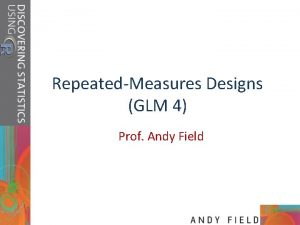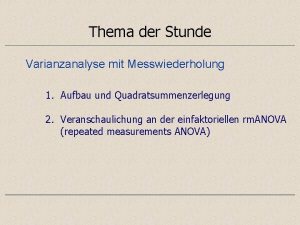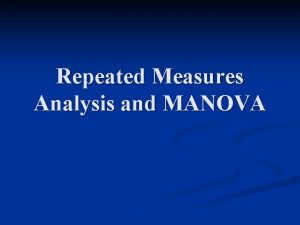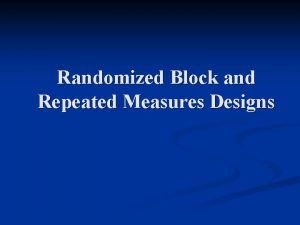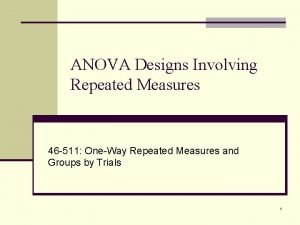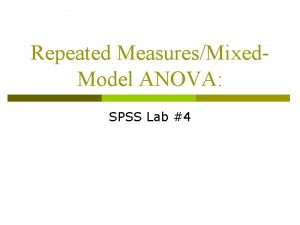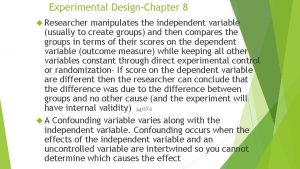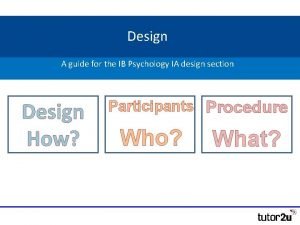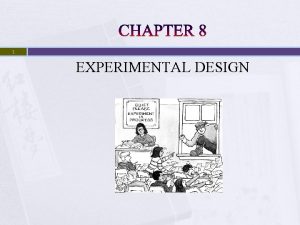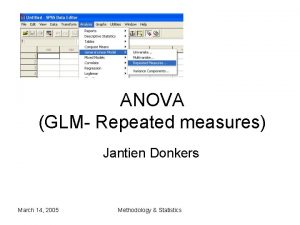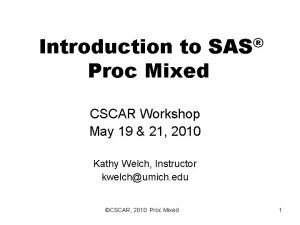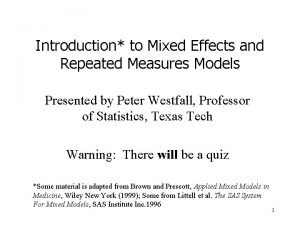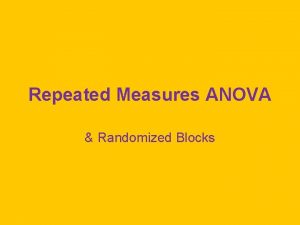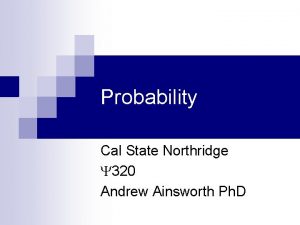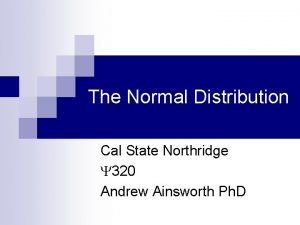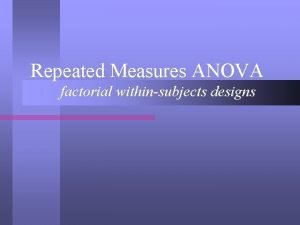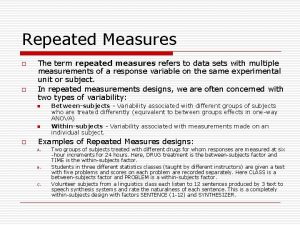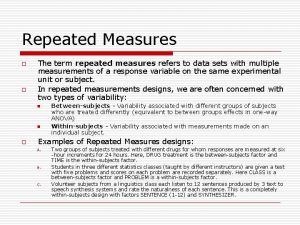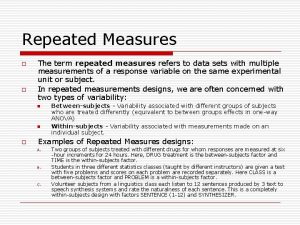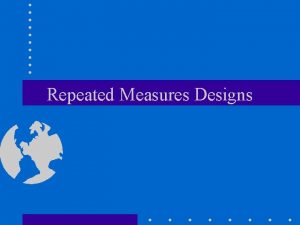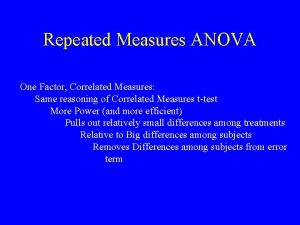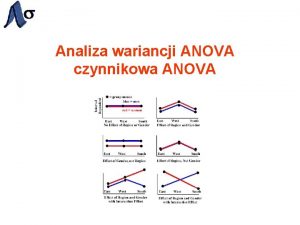Repeated Measures ANOVA Cal State Northridge 320 Andrew




























- Slides: 28

Repeated Measures ANOVA Cal State Northridge 320 Andrew Ainsworth Ph. D

Major Topics What are repeated-measures? An example Assumptions Advantages and disadvantages Effect size Psy 320 - Cal State Northridge 2

Repeated Measures? Between-subjects designs – different subjects serve in different treatment levels – (what we already know) Repeated-measures (RM) designs – each subject receives all levels of at least one independent variable – (what we’re learning today) Psy 320 - Cal State Northridge 3

Repeated Measures All subjects get all treatments. All subjects receive all levels of the independent variable. Different n’s are unusual and cause problems (i. e. dropout or mortality). Treatments are usually carried out one after the other (in serial). Psy 320 - Cal State Northridge 4

Example: Counseling For PTSD Foa, et al. (1991) – Provided supportive counseling (and otherapies) to victims of rape – Do number of symptoms change with time? • There’s no control group for comparison • Not a test of effectiveness of supportive counseling Psy 320 - Cal State Northridge 5

Example: Counseling For PTSD 9 subjects measured before therapy, after therapy, and 3 months later We are ignoring Foa’s other treatment conditions. Psy 320 - Cal State Northridge 6

Example: Counseling For PTSD Dependent variable = number of reported symptoms. Question: Do number of symptoms decrease over therapy and remain low? Data on next slide Psy 320 - Cal State Northridge 7

The Data 8

Preliminary Observations Notice that subjects differ from each other. – Between-subjects variability Notice that means decrease over time – Faster at first, and then more slowly – Within-subjects variability Psy 320 - Cal State Northridge 9

Partitioning Variability This partitioning is reflected in the summary table. Psy 320 - Cal State Northridge 10

Sums of Squares The total variability can be partitioned into Between Groups (e. g. measures), Subjects and Error Variability Psy 320 - Cal State Northridge 11

Deviation Sums of Squares Psy 320 - Cal State Northridge 12

Deviation Sums of Squares Psy 320 - Cal State Northridge 13

Deviation Sums of Squares Psy 320 - Cal State Northridge 14

Deviation Sums of Squares Psy 320 - Cal State Northridge 15

Computational Approach Psy 320 - Cal State Northridge 16

Computational Sums of Squares 17

Computational SS Example Psy 320 - Cal State Northridge 18

From BG ANOVA Degrees of Freedom Psy 320 - Cal State Northridge 19

Summary Table Fcrit with 2 and 16 degrees of freedom is 3. 63 we would reject h 0 Psy 320 - Cal State Northridge 20

Plot of the Data Psy 320 - Cal State Northridge 21

Interpretation Note parallel with diagram Note subject differences not in error term Note MSerror is denominator for F on Time Note SStime measures what we are interested in studying Psy 320 - Cal State Northridge 22

Assumptions Correlations between trials are all equal – Actually more than necessary, but close – Matrix shown below Psy 320 - Cal State Northridge 23

Assumptions Previous matrix might look like we violated assumptions – Only 9 subjects – Minor violations are not too serious. Greenhouse and Geisser (1959) correction (among many) – Adjusts degrees of freedom Psy 320 - Cal State Northridge 24

Multiple Comparisons With few means: – t test with Bonferroni corrections – Limit to important comparisons With more means: – Require specialized techniques • Trend analysis Psy 320 - Cal State Northridge 25

Advantages of RM Designs Eliminate subject differences from error term – Greater power Fewer subjects needed Often only way to address the problem – This example illustrates that case. Psy 320 - Cal State Northridge 26

Disadvantages of RM designs Carry-over effects – Counter-balancing May tip off subjects to what you are testing Some phenomenon cannot be tested in a repeated measure fashion (e. g. anything that requires tricking the participant) Psy 320 - Cal State Northridge 27

Effect Size Simple extension of what we said for t test for related samples. Stick to pairs of means. OR – 2 can be used for repeated measures data as well – Some adjustments can make it more meaningful Psy 320 - Cal State Northridge 28
 Cal state northridge psychology
Cal state northridge psychology Andy field repeated measures anova
Andy field repeated measures anova Repeated measures design psychology
Repeated measures design psychology Repeated-measures design
Repeated-measures design Anova messwiederholung
Anova messwiederholung Spss syntax editor
Spss syntax editor Manova in jmp
Manova in jmp Two-way repeated measure anova
Two-way repeated measure anova Repeated measures anova jmp
Repeated measures anova jmp Northridge blind thrust fault
Northridge blind thrust fault Costco kanata pharmacy
Costco kanata pharmacy Two-way repeated measure anova
Two-way repeated measure anova Cal and cal
Cal and cal Beda one way anova dan two way anova
Beda one way anova dan two way anova One way anova vs two way anova
One way anova vs two way anova Contoh kasus two way anova
Contoh kasus two way anova Multivariate anova spss
Multivariate anova spss Grouping factor
Grouping factor Repeated measures design psychology
Repeated measures design psychology Psychology unit 2
Psychology unit 2 Between subjects design vs within
Between subjects design vs within Repeated measures design psychology
Repeated measures design psychology Independent groups design
Independent groups design March
March Sas proc mixed
Sas proc mixed 7500000/52
7500000/52 Repeated measures design
Repeated measures design Largest cal state campus
Largest cal state campus Csudh financial aid
Csudh financial aid

